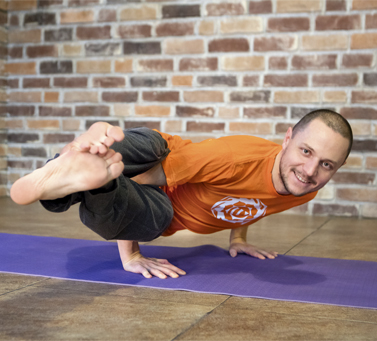
Once a yoga teacher was trying to help my friend to go deeper in Samakonasana with the teacher’s body weight. My friend asked the teacher not to do that, but her request was somehow overlooked. Maybe the teacher was not in a good mood that day; maybe she had a great wish to help my friend. Who knows now? But the result of that was injury.
From this example, we can see that the question about asana assisting and alignment is very important in yoga teaching and I am afraid the answer is very contradictive. Different teachers, different yoga schools have different, sometimes even the opposite viewpoints on this subject. For example, the school of Ananda Yoga tradition does not allow new yoga teachers correct students at all. The same is true for some yoga schools in India, where teachers of classical Hatha Yoga usually do not correct students. Instead, they demonstrate everything themselves. They practice along with their students, achieve a special psycho-energy state, and then share the energy with the class.
On the contrary, some of the most popular yoga traditions in the western countries, such as Ashtanga Yoga, Rocket Yoga, Power Yoga, and Iyengar Yoga, emphasize proper alignments and provide corrections accordingly. Here, teachers like helping students and sometimes force them too harshly, in my personal experience. Please understand me correctly, I am not saying it is wrong or anything. But if we check out the social media, we see a lot of teachers who are trying to attract people’s attention using advanced asanas. They “scream” from the posters, “Hey guys, my workshop is coming! I will teach you to do the same!” To me, these adverts only show these teachers do not really understand the goal of yoga, turning yoga from an ancient philosophy and lifestyle into unhealthy competition.
Based on my personal practice, my practice with other teachers, and my teaching experience, I have set up some rules for myself:
- Begin a class with a short breathing session and chanting Om three times to find the inner silence. It allows people in the room, including you as a teacher, to calm down. Also, use this time to observe and connect with the students. Try to understand the energy of every particular class and figure out what people really need today, instead of what you want to teach today.
- Practice with the students and provide options for different students. It allows to understand “the temperature” of the class (this is how I call it).
- Do not allow beginners to attend advanced classes. If they insist, always keep an eye on them.
- Correct students (1) when they are in danger; (2) when they are struggling with the props; (3) when they have difficulties with right and left. Besides that, it is great to let people explore and be connected with their bodies.
- End the class with a short breathing session, Om chanting and appreciation to the students in the class. Remember your students are your closest teachers at the same time.
In conclusion, I would like to say that even though the answer to asana assisting and alignments in yoga teaching is contradictive, all yoga teachers need to take care of their students. Instead of pushing people, share a holistic path with them to achieve the goal of yoga. Instead of damage, follow the ideas of creation and development. Om!